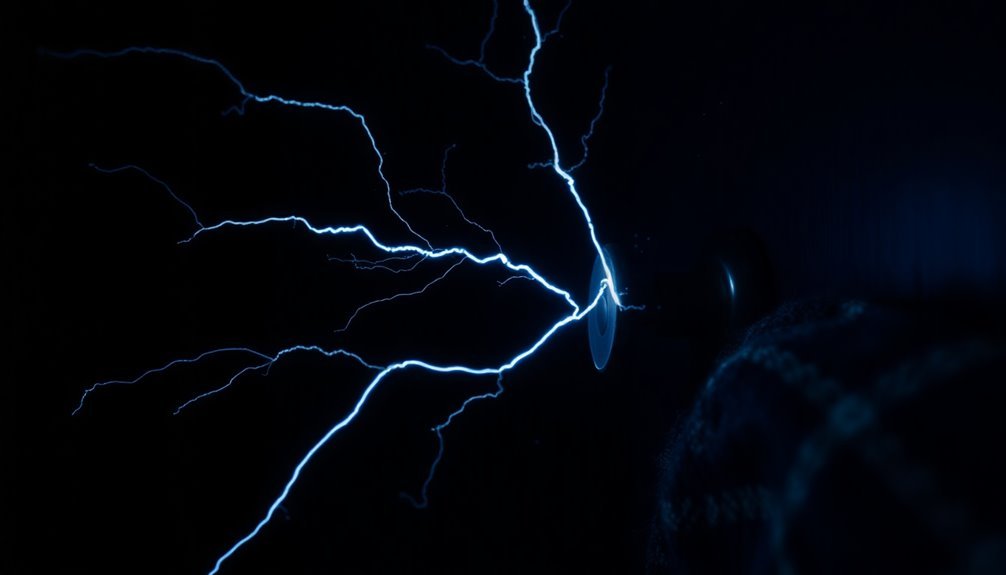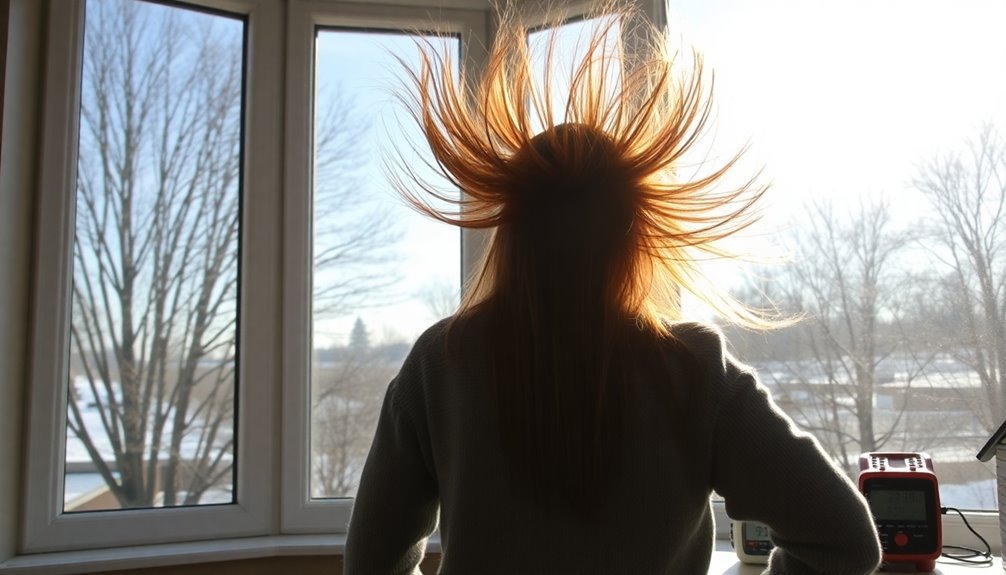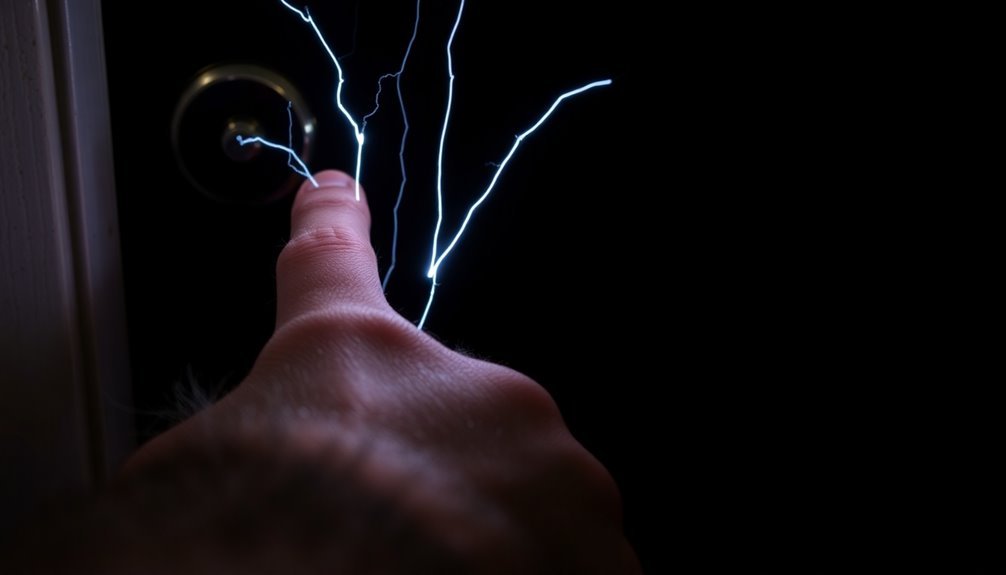Low humidity increases static electricity because dry air acts as an insulator rather than a conductor. When there's less moisture in the air, electrical charges can't easily flow and dissipate naturally into your environment. Instead, they build up on surfaces and your body, leading to those unexpected shocks you feel when touching doorknobs or other objects. Higher humidity levels provide water molecules that create natural conducting paths, allowing charges to disperse more effectively. By maintaining humidity levels between 40-60%, you'll experience fewer static problems. Understanding the relationship between moisture and static charge can help you better control your environment.
Understanding Static Electricity Fundamentals

Since the discovery of static electricity, scientists have worked to understand its fundamental nature. At its core, static electricity occurs when there's an imbalance between negative and positive charges within or on the surface of an object.
You'll encounter this phenomenon most commonly through friction between two materials, where electrons transfer from one surface to another. Natural elements like contact with metal can help neutralize these charges.
When you rub two materials together, you're actually forcing electrons to move from one object to the other. This transfer follows a principle known as the triboelectric series, where materials like wool are more likely to lose electrons and create static charges.
Once these charges build up on an object's surface, they'll stay there until they find a way to discharge, typically through contact with a conductive material.
The process isn't limited to friction alone. You can generate static electricity through other means, such as separating materials (like peeling tape) or applying pressure to certain substances through the piezoelectric effect.
In each case, you're creating an imbalance of charges that will seek to equalize, resulting in that familiar static discharge you've likely experienced.
Moisture's Role in Static Control
A vital relationship exists between moisture in the air and static electricity control. When relative humidity rises above 40%, you'll notice a significant reduction in static buildup, and at 55% RH, static charges are virtually eliminated. This occurs because moisture in the air acts as a natural conductor, allowing static charges to dissipate to the ground effectively. Drier and colder conditions typically increase static electricity problems during winter months.
| Humidity Level | Static Effect | Control Method |
|---|---|---|
| Below 40% RH | High static buildup | Immediate humidification needed |
| 40-55% RH | Reduced static | Maintain current levels |
| Above 55% RH | No static buildup | Monitor to prevent over-humidification |
You can control static electricity through moisture in two main ways. First, airborne water molecules provide pathways for charges to dissipate naturally. Second, surface moisture creates a conductive layer that allows static to leak away when objects are grounded. The effectiveness of this moisture-based control is remarkable, with studies showing 95-98% reduction in static charges when proper humidity levels are maintained. For practical applications, you'll find that evaporative humidifiers or localized spray systems near heat-generating equipment can effectively maintain these ideal moisture levels in your environment.
Weather Patterns and Static Buildup

Weather patterns play three critical roles in static electricity formation and control. First, they directly influence humidity levels, with dry conditions promoting static buildup while moist air helps dissipate charges.
Second, temperature variations affect how much moisture the air can hold, with cold winter air typically being drier and more conducive to static electricity. Maintaining relative humidity above 40% is essential for reducing static discharge risks.
Third, seasonal changes create predictable patterns of static electricity occurrence, making it easier for you to anticipate and address potential issues.
You'll notice static electricity becomes more problematic during winter months when cold, dry air combines with indoor heating to create low-humidity environments. This effect is particularly noticeable when you're running central heating systems, which further reduce indoor moisture levels.
In contrast, summer's naturally higher humidity levels typically reduce static problems, though air conditioning can create localized dry spots.
To manage these weather-related static issues, you can implement targeted solutions. Installing humidifiers helps maintain ideal moisture levels, while static control equipment can address specific problem areas.
Humidity Control Best Practices
Proper humidity control stands as your first line of defense against static electricity problems. To effectively manage static buildup, you'll need to maintain relative humidity levels between 40-60%, as static electricity becomes significant only when humidity drops below 40%. By keeping humidity above 55%, you'll virtually eliminate static electricity concerns altogether.
You can implement several proven methods to achieve ideal humidity control. Install humidifiers in your space, either as standalone units or integrated into your HVAC system. Regular maintenance of these systems helps protect valuable assets and extends equipment lifespan.
Monitor humidity levels regularly using hygrometers to identify areas that need adjustment. For larger spaces, consider implementing advanced control systems with sensors that automatically maintain desired humidity levels.
If you're dealing with excess moisture, use dehumidifiers or desiccant materials like silica gel. The two-temperature method works well for larger areas, handling up to 15,000 cubic feet per minute.
Whichever method you choose, remember that consistent maintenance is vital. You'll not only prevent static electricity but also improve air quality, increase safety for sensitive electronics, enhance productivity, and potentially reduce energy costs through better climate control.
Science Behind Electrical Charge Flow

Understanding electrical charge flow starts with a fundamental grasp of humidity's role in conductivity. When you're in an environment with high humidity, water molecules in the air create a natural conducting path that helps static charges dissipate more easily. This occurs because water is an excellent conductor of electricity, substantially reducing the air's electrical resistance.
You'll notice this principle in action when relative humidity drops below 40%. In these dry conditions, there's not enough moisture in the air to create effective conducting paths, so static charges build up and remain trapped on surfaces. Surface conductivity increases when moisture is present, allowing charges to move more freely.
The triboelectric effect, which involves electron exchange between surfaces, becomes more pronounced in low-humidity environments because there's no easy way for the charges to dissipate.
When humidity rises above 55%, you'll experience less static electricity because the moisture-rich air provides continuous pathways for charges to flow and neutralize. This explains why you're more likely to experience static shocks during winter months when indoor heating reduces humidity levels.
The relationship between humidity and charge flow is so noteworthy that even a modest increase in relative humidity can dramatically reduce static electricity problems.
Preventing Static Through Humidity Management
Managing indoor humidity levels effectively serves as your first line of defense against static electricity problems. You'll want to maintain humidity levels between 45-55% RH (relative humidity) to substantially reduce static buildup, as moist air provides a natural pathway for electrical charges to dissipate rather than accumulate.
You can implement several practical solutions to control humidity in your environment. Installing a whole-house humidifier offers thorough coverage, while individual room humidifiers work well for targeted areas. The triboelectric effect causes static buildup when materials repeatedly contact each other, making humidity control crucial.
If you're dealing with static in an industrial setting, you'll need to maintain humidity levels above 55% RH, possibly using atomizing nozzles or localized spray systems near heat-generating equipment.
Don't overlook supplementary measures that can enhance your humidity management strategy. You'll find that using natural fiber clothing instead of synthetics reduces static buildup, and anti-static mats or wristbands provide additional protection.
Indoor plants can help boost humidity levels naturally, while avoiding excessive ventilation prevents moisture loss. For immediate relief, you can apply anti-static hand lotion or use conductive footwear to prevent static shock during your daily activities.
Solutions for Static Sensitive Environments

In accordance with industry standards, static-sensitive environments require a multi-layered approach to protection. You'll need to implement thorough grounding solutions, including conductive mats, straps, and regular testing of all grounding connections. High humidity levels above 60% can significantly reduce static electricity buildup in your facility.
It's crucial to equip your workspace with ESD-safe workbenches, storage solutions, and specialized tools to maintain a static-free environment.
- Install ionizers in critical areas to neutralize airborne static charges
- Use antistatic sprays and treatments on surfaces and materials
- Implement proper grounding techniques for all equipment and personnel
- Maintain appropriate humidity levels through evaporative systems
Your protection strategy should include personal ESD safety measures like conductive clothing, wrist straps, and heel straps. Don't forget to provide proper training to guarantee everyone understands the importance of ESD safety protocols.
You can enhance your static control by using natural fibers in clothing and incorporating antistatic materials in your facility. For maximum protection, consider inerting critical areas with purified gases like argon or helium.
Remember to conduct regular maintenance and cleaning of equipment to prevent static buildup, and always verify the effectiveness of your grounding systems through routine inspections.
Frequently Asked Questions
Can Static Electricity Affect the Accuracy of Digital Scales and Measuring Equipment?
Yes, static electricity can disrupt your digital scales' accuracy, causing measurement drift and errors. You'll notice it especially affects analytical balances and creates issues when weighing powdery substances in dry environments.
Does Wearing Certain Types of Jewelry Increase the Risk of Static Shock?
Yes, you'll experience more static shocks when wearing metal jewelry because it's highly conductive. Your rings, watches, and bracelets can accumulate and discharge static electricity more easily than your body alone.
Why Do Some People Experience More Static Shocks Than Others?
You'll experience more static shocks if you wear synthetic clothes, have dry skin, or frequently walk on carpets. Your daily activities and the materials you interact with directly affect your static electricity build-up.
Can Static Electricity Interfere With Wireless Signals and Bluetooth Connections?
Yes, your static electricity can disrupt wireless signals and Bluetooth connections by creating RF interference. You'll notice this more in low-humidity environments where static buildup is greater, causing connection issues and slowdowns.
Does Static Electricity Build-Up Affect Plant Growth in Indoor Environments?
Yes, static electricity can harm your indoor plants' growth by disrupting their cellular processes, reducing photosynthesis, and affecting nutrient uptake. You'll notice slower growth, reduced flowering, and decreased fruit production without proper humidity control.
In Summary
You've learned that low humidity creates the perfect environment for static electricity because there's less moisture in the air to help dissipate electrical charges. When you're dealing with dry conditions, electrons build up more easily on surfaces since they can't flow through water molecules. By maintaining proper humidity levels in your space, you'll reduce those annoying static shocks and protect sensitive equipment.





Leave a Reply